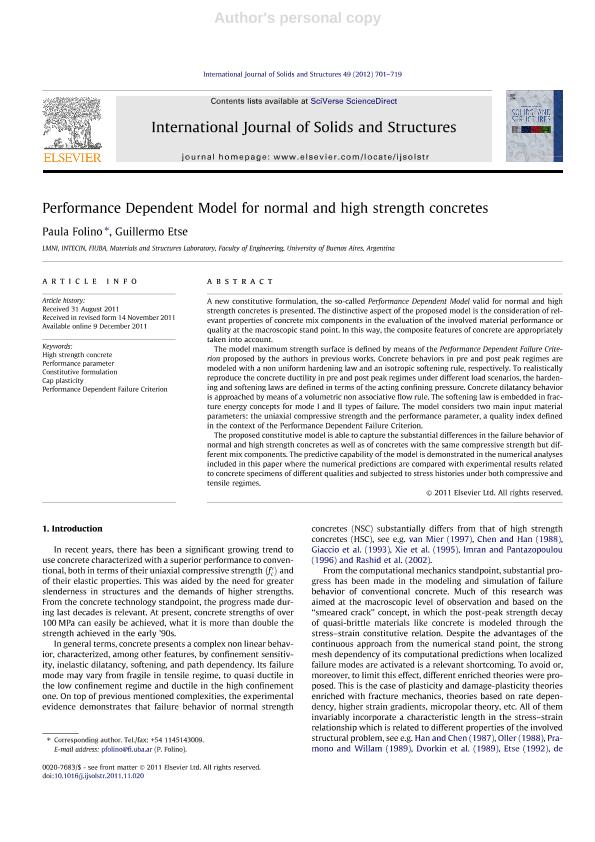Mostrar el registro sencillo del ítem
dc.contributor.author
Folino, Paula

dc.contributor.author
Etse, Jose Guillermo

dc.date.available
2019-05-27T19:48:05Z
dc.date.issued
2012-03
dc.identifier.citation
Folino, Paula; Etse, Jose Guillermo; Performance dependent model for normal and high strength concretes; Pergamon-Elsevier Science Ltd; International Journal Of Solids And Structures; 49; 5; 3-2012; 701-719
dc.identifier.issn
0020-7683
dc.identifier.uri
http://hdl.handle.net/11336/77262
dc.description.abstract
A new constitutive formulation, the so-called Performance Dependent Model valid for normal and high strength concretes is presented. The distinctive aspect of the proposed model is the consideration of relevant properties of concrete mix components in the evaluation of the involved material performance or quality at the macroscopic stand point. In this way, the composite features of concrete are appropriately taken into account.<br /><br />The model maximum strength surface is defined by means of the Performance Dependent Failure Criterion proposed by the authors in previous works. Concrete behaviors in pre and post peak regimes are modeled with a non uniform hardening law and an isotropic softening rule, respectively. To realistically reproduce the concrete ductility in pre and post peak regimes under different load scenarios, the hardening and softening laws are dened in terms of the acting conning pressure. Concrete dilatancy behavior is approached by means of a volumetric non associative fow rule. The softening law is embedded in fracture energy concepts for mode I and II types of failure. The model considers two main input material parameters: the uniaxial compressive strength and the performance parameter, a quality index defined in the context of the Performance Dependent Failure Criterion.<br /><br />The proposed constitutive model is able to capture the substantial differences in the failure behavior of normal and high strength concretes as well as of concretes with the same compressive strength but different mix components. The predictive capabilities of the model are demonstrated in the numerical analyses included in this paper where the numerical predictions are compared with experimental results related to concrete specimens of different qualities and subjected to stress histories under both compressive and tensile regimes.<br /><br />
dc.format
application/pdf
dc.language.iso
eng
dc.publisher
Pergamon-Elsevier Science Ltd

dc.rights
info:eu-repo/semantics/openAccess
dc.rights.uri
https://creativecommons.org/licenses/by-nc-sa/2.5/ar/
dc.subject
High Strength Concrete
dc.subject
Performance Parameter
dc.subject
Constitutive Formulation
dc.subject
Cap Plasticity
dc.subject.classification
Recubrimientos y Películas

dc.subject.classification
Ingeniería de los Materiales

dc.subject.classification
INGENIERÍAS Y TECNOLOGÍAS

dc.subject.classification
Recubrimientos y Películas

dc.subject.classification
Ingeniería de los Materiales

dc.subject.classification
INGENIERÍAS Y TECNOLOGÍAS

dc.title
Performance dependent model for normal and high strength concretes
dc.type
info:eu-repo/semantics/article
dc.type
info:ar-repo/semantics/artículo
dc.type
info:eu-repo/semantics/publishedVersion
dc.date.updated
2019-05-23T14:51:10Z
dc.journal.volume
49
dc.journal.number
5
dc.journal.pagination
701-719
dc.journal.pais
Estados Unidos

dc.journal.ciudad
San Diego
dc.description.fil
Fil: Folino, Paula. Universidad de Buenos Aires. Facultad de Ingeniería; Argentina
dc.description.fil
Fil: Etse, Jose Guillermo. Consejo Nacional de Investigaciones Científicas y Técnicas. Oficina de Coordinación Administrativa Houssay. Instituto de Tecnologías y Ciencias de la Ingeniería "Hilario Fernández Long". Universidad de Buenos Aires. Facultad de Ingeniería. Instituto de Tecnologías y Ciencias de la Ingeniería "Hilario Fernández Long"; Argentina. Universidad Nacional de Tucumán. Facultad de Ciencias Exactas y Tecnología. Centro de Métodos Numéricos y Computacionales en Ingeniería; Argentina
dc.journal.title
International Journal Of Solids And Structures

dc.relation.alternativeid
info:eu-repo/semantics/altIdentifier/url/https://www.sciencedirect.com/science/article/pii/S0020768311004021?via%3Dihub
dc.relation.alternativeid
info:eu-repo/semantics/altIdentifier/doi/https://dx.doi.org/10.1016/j.ijsolstr.2011.11.020
Archivos asociados
